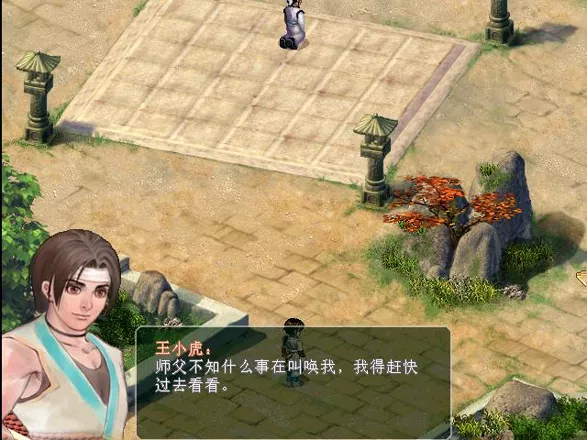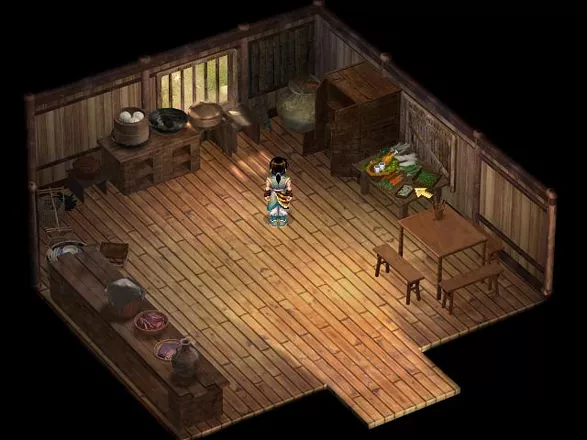Xianjian Qixia Zhuan 2
Description official description
Kung-fu has many different teachings, and one of them is Xianjian - magic sword. Li Xiaoyao, the hero of the first Xianjian Qixia Zhuan, has become the leader of this school. But another teaching, called Emei, is gaining popularity among disciples of king-fu. The head of Emei school, a man named Qian Ye ("Thousand Leaves"), is admired by simple people. Will there be cooperation or conflict between these two kung-fu masters?
Meanwhile, a tower where ancient demons were once sealed has been destroyed. Demons broke free and began to roam China undisturbed. Many heroes are ready to face the challenge of defeating those demons. Among those is a young man, Li Xiaoyao's former neighbor, named Wang Xiaohu. Li Xiaoyao refused to teach Wang Xiaohu martial arts, and the boy realized that he will have to prove to kung-fu masters and the whole world that he can become a worthy heir to Li Xiaoyao and his Xianjian technique.
Xianjian Qixia Zhuan 2 is a sequel to Xianjian Qixia Zhuan, utilizing the same gameplay system as its predecessor. The player navigates the characters through isometric locations (now with pre-rendered backgrounds) and fights enemies in turn-based style, using regular attacks, sword techniques, and magic spells. The battles are also viewed from an isometric perspective, and the enemies are visible on screen before a contact with them initiates a battle. Gameplay additions include the ability to conjure powerful creatures to assist the party in combat, as well as a magic system that requires characters to mark the battle field with a particular element in order to gain tactical advantage over the enemy.
Spellings
- 仙剑奇侠传2 - Chinese spelling (Simplified)
- 仙劍奇俠傳二 - Chinese spelling (Traditional)
Groups +
Screenshots
Promos
Reviews
Players
Average score: 3.6 out of 5 (based on 4 ratings with 2 reviews)
It's just a normal, typical Chinese RPG
The Good
The story comes after the first Xianjian Qixia Zhuan, it tells us what happened to the heroes after the end of the first game.
The Bad
I don't think there are any highlights in the game. It doesn't mean that the graphics, story and music are very poor, but they are just normal. Because in China, we regard Xianjian Qixia Zhuan series as a famous brand, so Chinese almost cannot bear a game without any innovations.
And the battles are too easy, there won't be any challenge in the game.
The Bottom Line
It's just a normal game, with normal story, normal graphics, normal sounds, normal battles, normal characters, normal masters, normal skills, normal magics, normal spells.
The conclusion: it's only a normal game. Trust me.
Windows · by Fading3 (19) · 2005
Love, werefoxes, and Buddhist disputes could have given us more
The Good
The first Xianjian Qixia Zhuan game was a big hit in China. Surprisingly, Softstar took its time, releasing the sequel much later than expected.
There are several noticeable (mostly gameplay-related) improvements in the sequel. What I disliked most in the first game were the endless mazes with annoying respawning enemies. I was pleased to discover that the sequel corrected this flaw. The mazes in this game are much smaller and much easier to navigate. There are still all kinds of passages to find and treasures to collect, but it gets nowhere near the monotonous corridors of the first game.
The first game had also had serious problems with gameplay balance. In the sequel, they corrected the balance issue (finally, enemies in later dungeons give you appropriate amount of experience, so you'll never feel the urge to avoid enemies like in the first game), and also added some really cool touches to the combat system. One of them is Li Yiru's ability to summon monsters. Some of the bosses become your possession after you defeat them, and fight on your side as playable characters. You can have up to two such creatures summoned in a battle. Their actions are controlled by AI, but you can assign a general strategy, telling them to concentrate on attack magic, defensive spells, and so on. Those monsters gain strength the more you use them, and become pretty much indispensable for major battles.
Another very nice addition is the "magic field" spells Qiqi can cast. Such spells raise the power of a certain element, and lower the power of the opposing one. So if for example you are fighting a boss who likes using fire magic, what you can do is summon the beautiful ice goddess and then have Qiqi cast an "ice strong - fire low" spell. It will mark the field with ice element, and it will remain so until the end of the battle. Of course, not all is simple, and if you meet a group of enemies who use both ice and fire spells, you'll have to think twice.
Yet another innovation are Wang Xiaohu's tiger attacks ("xiao hu" meaning "little tiger" in Chinese), which require special "tiger" points that you accumulate by repeatedly attacking in battles.
Like in the first game, your HP and MP are restored slightly after each battle, and you are fully healed when you gain a level. You can increase your stats by repeatedly doing an appropriate action: attack a lot and your vitality will increase, cast a lot of spells and you'll gain higher magic power, etc. There are loads of weapons, accessories, and items to find and to try out. And probably the most important feature: there are no random battles, and you can save anywhere. Two of the things many people dislike most in Japanese-style RPGs are absent here.
The second game also handles the "no random battles" aspect significantly better than the first. In the first one, enemies were respawning automatically the moment you left the room and entered it again. They were also much more numerous, aggressive, and hard to avoid. The combination with the sheer complexity of the mazes and the necessity to backtrack almost made me wish the battles were random. In the second game, everything is much more balanced.
Visually, the game represents the "lost art" of 2D graphics. Though technically way behind the times, the graphical style has a charm that is not always present in 3D games. The music is expressive and catchy. Some melodies are recycled from the first game, including much of the battle music. A refreshing change is the abundance of battle melodies; there is no "standard" battle theme, but about four or five of them, if not more.
The Bad
The difficulty level is still pretty uneven. Some bosses are very easy; others are an absolute pain. The game also has the nasty habit of taking characters away from the party just when you need them most.
Xianjian Qixia Zhuan 2 is, once again, absolutely linear. It is so linear that it makes most other Japanese-style RPGs look like sandbox experiences in an open world. It is, in fact, even more linear than the previous game, and that's saying a lot. The game is simply a journey from one location to another. There is no "world map", and no places to explore besides those the game takes you to automatically.
The worst part of it is the final stretch. Without knowing that the last town was really last, I decided to spare money and didn't buy the most expensive weapons and healing items. But when I found myself having trouble in the last dungeon, I discovered, to my amazement, that I couldn't even go back to that town to buy more supplies.
Dreadful linearity is coupled with a minuscule size. The game is noticeably shorter than its predecessor and doesn't feel "epic" in the least. There are barely any towns in the game, and the whole thing feels somewhat rushed and reduced, as if large portions of the game were cut out during development.
That would be less of a problem if the initial premise and the subsequent plot were more exciting. Unfortunately, it's quite lukewarm by Chinese standards. With a few exceptions, the characters are not particularly interesting, and the endearing tragic romances from the first game are replaced by pretty mild emotional exchanges that do not live up to its tear-jerking progenitor.
The Bottom Line
The long-awaited sequel to the most popular Chinese RPG corrects many flaws that plagued its famed predecessor, or at least makes them much more tolerable. However, its tiny size, depressing linearity and toned-down emotional intensity make it less than the stellar follow-up it strove to be.
Windows · by Unicorn Lynx (181798) · 2015
Analytics
Identifiers +
Contribute
Are you familiar with this game? Help document and preserve this entry in video game history! If your contribution is approved, you will earn points and be credited as a contributor.
Contributors to this Entry
Game added by Unicorn Lynx.
iPad, iPhone added by Ms. Tea.
Additional contributors: pedantic, Rik Hideto.
Game added September 30th, 2005. Last modified August 17th, 2023.



















